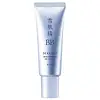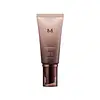What's inside
What's inside
 Key Ingredients
Key Ingredients

 Benefits
Benefits

 Concerns
Concerns

 Ingredients Side-by-side
Ingredients Side-by-side

Water
Skin ConditioningCyclopentasiloxane
EmollientEthylhexyl Methoxycinnamate
UV AbsorberIsotridecyl Isononanoate
EmollientAlcohol Denat.
AntimicrobialPEG-9 Polydimethylsiloxyethyl Dimethicone
EmulsifyingMethyl Trimethicone
Skin ConditioningDiethylamino Hydroxybenzoyl Hexyl Benzoate
UV FilterEthylhexyl Palmitate
EmollientMel Extract
MoisturisingTocopherol
AntioxidantRosa Canina Fruit Extract
AstringentPimpinella Anisum Seed Extract
AstringentHydrolyzed Safflower Flower Extract
Skin ConditioningBourbon Extract
AstringentLimnanthes Alba Seed Oil
Skin ConditioningCucumis Melo Root Extract
HumectantHydrolyzed Rice Leaf Extract
AntioxidantButylene Glycol
HumectantBHT
AntioxidantEthylhexyl Acrylate
Alumina
AbrasiveSilica
AbrasiveDimethicone
EmollientPrenol
PerfumingPolymethylsilsesquioxane
Methyl Methacrylate Crosspolymer
Lauryl PEG-9 Polydimethylsiloxyethyl Dimethicone
Skin ConditioningPolyglyceryl-10 Laurate
Skin ConditioningZinc Chloride
AntimicrobialSynthetic Fluorphlogopite
Tin Oxide
AbrasivePotassium Hydroxide
BufferingCetyl Lactate
EmollientPhenoxyethanol
PreservativeTitanium Dioxide
Cosmetic ColorantZinc Oxide
Cosmetic ColorantCI 77492
Cosmetic ColorantWater, Cyclopentasiloxane, Ethylhexyl Methoxycinnamate, Isotridecyl Isononanoate, Alcohol Denat., PEG-9 Polydimethylsiloxyethyl Dimethicone, Methyl Trimethicone, Diethylamino Hydroxybenzoyl Hexyl Benzoate, Ethylhexyl Palmitate, Mel Extract, Tocopherol, Rosa Canina Fruit Extract, Pimpinella Anisum Seed Extract, Hydrolyzed Safflower Flower Extract, Bourbon Extract, Limnanthes Alba Seed Oil, Cucumis Melo Root Extract, Hydrolyzed Rice Leaf Extract, Butylene Glycol, BHT, Ethylhexyl Acrylate, Alumina, Silica, Dimethicone, Prenol, Polymethylsilsesquioxane, Methyl Methacrylate Crosspolymer, Lauryl PEG-9 Polydimethylsiloxyethyl Dimethicone, Polyglyceryl-10 Laurate, Zinc Chloride, Synthetic Fluorphlogopite, Tin Oxide, Potassium Hydroxide, Cetyl Lactate, Phenoxyethanol, Titanium Dioxide, Zinc Oxide, CI 77492
Water
Skin ConditioningCI 77891
Cosmetic ColorantCyclopentasiloxane
EmollientDipropylene Glycol
HumectantPanax Ginseng Root Extract
EmollientPhenyl Trimethicone
Skin ConditioningButyloctyl Salicylate
Skin ConditioningCetyl PEG/PPG-10/1 Dimethicone
EmulsifyingButylene Glycol
HumectantCyclohexasiloxane
EmollientNiacinamide
SmoothingTalc
AbrasiveCalcium Stearate
Cosmetic ColorantMagnesium Sulfate
Sorbitan Sesquioleate
EmulsifyingCI 77492
Cosmetic ColorantTocopheryl Acetate
AntioxidantDimethicone
EmollientSynthetic Beeswax
Emulsion StabilisingAluminum Hydroxide
EmollientHydrogenated Polyisobutene
EmollientStearic Acid
CleansingPhenoxyethanol
PreservativeCaprylyl Glycol
EmollientCI 77491
Cosmetic ColorantGlycerin
HumectantTriethoxycaprylylsilane
Disteardimonium Hectorite
StabilisingCI 77499
Cosmetic ColorantSilica
AbrasiveAlcohol
Antimicrobial1,2-Hexanediol
Skin ConditioningDisodium EDTA
Triethyl Citrate
MaskingHydroxyethylcellulose
Emulsion StabilisingAdenosine
Skin ConditioningParfum
MaskingDimethicone Crosspolymer
Emulsion StabilisingEthylhexylglycerin
Skin ConditioningBeeswax
Emulsion StabilisingDimethicone/Vinyl Dimethicone Crosspolymer
Skin ConditioningCellulose
AbsorbentSodium Hyaluronate
HumectantPolymethylsilsesquioxane
CI 77480
Cosmetic ColorantBifida Ferment Lysate
Skin ConditioningCentella Asiatica Extract
CleansingLactose
HumectantSilica Silylate
EmollientPanthenol
Skin ConditioningDisodium Stearoyl Glutamate
CleansingDisodium Phosphate
BufferingPolysorbate 60
EmulsifyingMadecassoside
AntioxidantSodium Phosphate
BufferingButylphenyl Methylpropional
PerfumingBenzyl Benzoate
AntimicrobialWater, CI 77891, Cyclopentasiloxane, Dipropylene Glycol, Panax Ginseng Root Extract, Phenyl Trimethicone, Butyloctyl Salicylate, Cetyl PEG/PPG-10/1 Dimethicone, Butylene Glycol, Cyclohexasiloxane, Niacinamide, Talc, Calcium Stearate, Magnesium Sulfate, Sorbitan Sesquioleate, CI 77492, Tocopheryl Acetate, Dimethicone, Synthetic Beeswax, Aluminum Hydroxide, Hydrogenated Polyisobutene, Stearic Acid, Phenoxyethanol, Caprylyl Glycol, CI 77491, Glycerin, Triethoxycaprylylsilane, Disteardimonium Hectorite, CI 77499, Silica, Alcohol, 1,2-Hexanediol, Disodium EDTA, Triethyl Citrate, Hydroxyethylcellulose, Adenosine, Parfum, Dimethicone Crosspolymer, Ethylhexylglycerin, Beeswax, Dimethicone/Vinyl Dimethicone Crosspolymer, Cellulose, Sodium Hyaluronate, Polymethylsilsesquioxane, CI 77480, Bifida Ferment Lysate, Centella Asiatica Extract, Lactose, Silica Silylate, Panthenol, Disodium Stearoyl Glutamate, Disodium Phosphate, Polysorbate 60, Madecassoside, Sodium Phosphate, Butylphenyl Methylpropional, Benzyl Benzoate
Ingredients Explained
These ingredients are found in both products.
Ingredients higher up in an ingredient list are typically present in a larger amount.
Butylene Glycol (or BG) is used within cosmetic products for a few different reasons:
Overall, Butylene Glycol is a safe and well-rounded ingredient that works well with other ingredients.
Though this ingredient works well with most skin types, some people with sensitive skin may experience a reaction such as allergic rashes, closed comedones, or itchiness.
Learn more about Butylene GlycolCi 77492 is also hydrated iron III oxide. It's sole purpose is to give a yellow hue to products.
Iron III oxides are classified as inorganic chemicals for coloring.
Synthetically created Ci 77492 is considered safer than those naturally found. This is because the synthetically created version may contain less impurities. Iron oxides are generally non-toxic and non-allergenic.
Learn more about CI 77492Cyclopentasiloxane, or D5, is a silicone used to improve texture of products and trap moisture.
D5 is considered lightweight and volatile. Volatile means it evaporates quickly after application. Once evaporated, D5 leaves a thin barrier that helps keep skin hydrated.
It is also an emollient. Emollients help soften the skin and prevent water loss. Silicones create a silky texture in products. D5 helps other ingredients become more spreadable.
Studies show D5 is safe to use in skincare products. We recommend speaking with a skincare professional if you have concerns.
Learn more about CyclopentasiloxaneDimethicone is a type of synthetic silicone created from natural materials such as quartz.
What it does:
Dimethicone comes in different viscosities:
Depending on the viscosity, dimethicone has different properties.
Ingredients lists don't always show which type is used, so we recommend reaching out to the brand if you have questions about the viscosity.
This ingredient is unlikely to cause irritation because it does not get absorbed into skin. However, people with silicone allergies should be careful about using this ingredient.
Note: Dimethicone may contribute to pilling. This is because it is not oil or water soluble, so pilling may occur when layered with products. When mixed with heavy oils in a formula, the outcome is also quite greasy.
Learn more about DimethiconePhenoxyethanol is a preservative that has germicide, antimicrobial, and aromatic properties. Studies show that phenoxyethanol can prevent microbial growth. By itself, it has a scent that is similar to that of a rose.
It's often used in formulations along with Caprylyl Glycol to preserve the shelf life of products.
Polymethylsilsesquioxane is a silicone used as a film forming agent.
When applied to the skin, this ingredient creates an invisible film on the surface. This film still allows oxygen to pass through, but prevents moisture from escaping. This can help condition and hydrate the skin. It also leaves a silky feel when applied.
Polymethylsilsesquioxane has not been shown to clog pores. It has been deemed safe to use up to 55%, but most cosmetics use much less.
If you have concerns about using this ingredient, we recommend speaking with a professional.
Learn more about PolymethylsilsesquioxaneSilica, also known as silicon dioxide, is a naturally occurring mineral. It is used as a fine, spherical, and porous powder in cosmetics.
Though it has exfoliant properties, the function of silica varies depending on the product.
The unique structure of silica enhances the spreadability and adds smoothness, making it a great texture enhancer.
It is also used as an active carrier, emulsifier, and mattifier due to its ability to absorb excess oil.
In some products, tiny microneedles called spicules are made from silica or hydrolyzed sponge. When you rub them in, they lightly polish away dead skin layers and enhance the penetration of active ingredients.
Learn more about SilicaWater. It's the most common cosmetic ingredient of all. You'll usually see it at the top of ingredient lists, meaning that it makes up the largest part of the product.
So why is it so popular? Water most often acts as a solvent - this means that it helps dissolve other ingredients into the formulation.
You'll also recognize water as that liquid we all need to stay alive. If you see this, drink a glass of water. Stay hydrated!
Learn more about Water